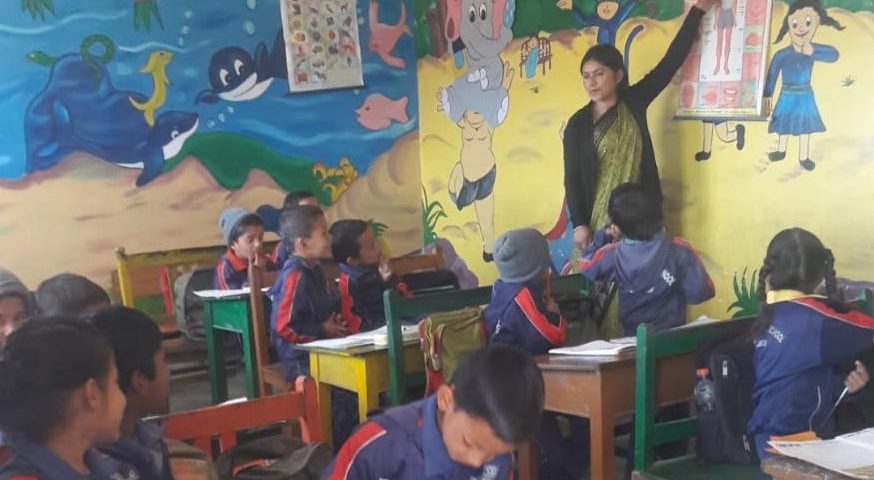
Hard Work Pays Off: HIC Students Shine in Uttarakhand Board Exams
May 23, 2024
Bhawna Bhauryal : Serving the nation – A cadet’s calling
July 11, 2024Green hour : Time to connect with Nature and care for environment

The Himalaya, the “abode of snow,” is a treasure trove of natural wonders. From towering snow peaks to lush green valleys, perennial rivers to vibrant ecosystems, these mountains hold an unsurpassed beauty and ecological significance.
Himalayan Inter College (HIC), Chaukori is nestled in the middle Himalayan ranges at the height of 1800 meters in the Kumaon region of Uttarakhand state in India. Himalayan Education Foundation (HEF), since its association with HIC, has been keen to encourage eco-friendly thinking among the students by sponsoring outdoor education programs and implementing green technologies like a solar heating facility and solar power generation for the school.
Location of Chaukori in the tri junction area of India, Nepal and Tibet
The past two decades have witnessed immense change in the Himalayas. Growing populations, environmental pollution, and a decline in forests and wildlife have all emerged as major challenges. These concerns, along with increasing man-animal conflict, forest fires, and the climate crisis, endanger not only the local ecosystems but also the living conditions of the humans in the Himalayas and beyond.
Living amidst the grandeur of the mountains, the students can sometimes find themselves caught up in the routines of school life, missing the chance to truly connect with the nature that surrounds them. Disconnection from nature and ignorance of environmental problems brought about by modern technologies further alienate them from the natural environment.
Realising the importance and relevance of the environment and its impact on the communities and individuals, HEF proposed to include a curriculum for Nature and Environmental Education (NEE) for sensitising students about the natural wealth of the region and the threats it faces from human activities. This initiative would help them to think and act in eco-friendly ways. Responding positively, Prakash Karki, director, HIC, says, “ It is essential, given the current climate crisis, for students to be literate about environmental issues that affect the fragile ecosystems in the HImalayas. The community’s survival itself would be at stake, if these issues are not resolved.”
“In this regard we plan to include a Green Hour in students’ weekly time table, start a Nature Club, conduct extra curricular events and reach out to the local community and partner with organisations for support and collaboration”, Prakash elaborates on HIC’s plans to implement this educational initiative.
Construction boom at Chaukori
“The aim is to integrate Environmental education into the school day. With the help and guidance of our instructors, students learn and practise green thinking. There are outdoor sessions in which experiential learning is facilitated through practical activities. In Indoor sessions, students watch nature documentaries, discuss their local environmental issues, present their findings etc.”
HEF encourages HIC to see itself as a part of a larger community, caring for its well being, as strengthening the community enhances the welfare of all its members. Expressing his thoughts on these issues, Raj Mahara, an instructor at HIC, states, “ How well a community does depends on the health of its environment. We reach out to the local people by organising environment and nature awareness campaigns and clean-up drives in our education outreach initiatives.” With support from HEF, Raj recently conducted the Chaukori Bird Watching festival, which was attended by more than 100 students from different schools in the region.
The greater Himalayan range as seen from Chaukori
Stressing the need for active participation by students, Prakash says, “ Among other activities, the proposed Nature Club can facilitate student-led hikes to the nearby Himalayan glaciers and alpine meadows. Trekking and camping outdoors gives them a better appreciation of the natural world. Quiz competitions, photography and painting contests, talks by environmentalists and scientists, workshops by wildlife experts, nature photographers are some of its activities to enable students to connect with nature and foster green thinking.”
“This is a new challenge for us. We need resources to achieve our green aims. We are glad to receive support and encouragement from HEF in implementing Nature and Environmental Education (NEE) at HIC”, Prakash further elaborates on the way forward. “We would like to network with schools and organisations working on similar issues and learn from their experiences in designing and carrying out our mission.”
HIC’s initiatives like the Green Hour curriculum, Nature Club, and community outreach programs offer a promising path to raise student awareness of environmental challenges faced by hill communities. We at HEF, with our dedication to empowering communities through education, are excited to support these programs and contribute to finding innovative solutions to environmental crises.
Kumaon landscape



